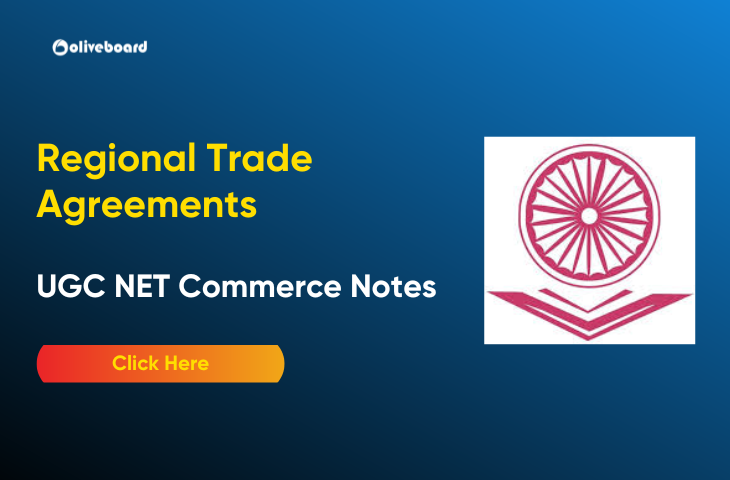Regional Economic Integration is a key concept in UGC NET Commerce, focusing on agreements among countries to enhance economic cooperation and eliminate trade barriers. The syllabus covers Levels of Regional Economic Integration Free Trade Area, Customs Union, Common Market, Economic Union, and Political Union. It examines Trade Creation (efficiency gains) and Trade Diversion (shifts in trade patterns due to preferential agreements). Specific examples like the European Union (EU), ASEAN, SAARC, and NAFTA highlight the evolution and impact of Regional Trade Agreements (RTAs) on global trade dynamics. This topic, vital for understanding international business, typically accounts for 1–2 questions in Paper 2 of the UGC NET exam, emphasizing concepts, examples, and application-based scenarios. A strong grasp of trade effects and RTAs is essential for aspiring educators and commerce professionals to analyze regional economic impacts critically.
What is Regional Trade Agreements (RTAs)?
What are RTAs?
- Regional Trade Agreements (RTAs) are treaties between two or more countries within a specific region to facilitate trade by reducing or eliminating trade barriers, such as tariffs and quotas.
Types of RTAs
- Free Trade Agreements (FTAs)
- Customs Unions
- Common Markets
- Economic Unions
Significance in Global Trade
- Trade Liberalization
- Economic Integration
- Market Expansion: RTAs provide businesses access to larger markets, increasing trade volume and investment opportunities.
- Competitive Advantage: Strengthen the competitiveness of member nations by leveraging regional strengths and resources.
- Global Supply Chain
- Political and Economic Stability
- Adaptation to Globalization
European Union (EU)
Historical Background and Formation
- Origins: The EU traces its origins to the European Coal and Steel Community (ECSC) in 1951 and the European Economic Community (EEC) in 1957, which aimed at economic cooperation and preventing future conflicts in Europe.
- Formation: The Treaty of Maastricht (1992) formally established the European Union, marking a shift toward political and economic integration.
- Founding Members: Initially, six countries: Belgium, France, Germany, Italy, Luxembourg, and the Netherlands.
Objectives and Key Features
- Enhance political and economic stability in Europe, preventing wars and fostering peaceful cooperation.
- Create a single market allowing the free movement of goods, services, people, and capital.
- Introduction of a common currency, the Euro, to promote economic stability.
- Focus on economic growth, environmental protection, and social inclusion.
- Foster a unified approach to external relations, security, and defense.
- Promote balanced regional development and reduce economic disparities between member states.
Member Countries
- Current Members: 27 European countries, including France, Germany, Italy, Spain, the Netherlands, and others.
- Notable Exits: The United Kingdom (UK) formally left the EU in 2020 after a referendum known as Brexit.
- Expansion: The EU has expanded over time, especially after the fall of the Soviet Union, incorporating countries from Central and Eastern Europe.
Download UGC NET Paper 1 People, Development and Environment Notes
ASEAN (Association of Southeast Asian Nations)
Origin and Purpose
- ASEAN was founded on August 8, 1967, in Bangkok, Thailand, by five founding members: Indonesia, Malaysia, the Philippines, Singapore, and Thailand.
- Purpose:
- Promote regional stability, economic cooperation, and peace in Southeast Asia.
- Foster mutual respect for cultural diversity and non-interference in domestic affairs.
Member Nations
ASEAN has 10 member countries:
- Brunei
- Cambodia
- Indonesia
- Laos
- Malaysia
- Myanmar
- Philippines
- Singapore
- Thailand
- Vietnam
Trade Initiatives and Economic Integration
- ASEAN Free Trade Area (AFTA):
- Established in 1992, AFTA aims to reduce tariffs and trade barriers within the region, encouraging intra-ASEAN trade.
- ASEAN Economic Community (AEC):
- Established in 2015, AEC seeks to create a single market and production base in Southeast Asia, allowing the free flow of goods, services, investments, skilled labor, and capital.
- ASEAN Trade in Goods Agreement (ATIGA):
- Provides a framework for the elimination of tariffs on goods traded between member countries, aiming to boost intra-ASEAN trade.
- External Trade Agreements:
- ASEAN has signed free trade agreements with major economies such as China, Japan, South Korea, and Australia. These agreements enhance regional trade and cooperation.
SAARC (South Asian Association for Regional Cooperation)
Formation
- SAARC was established on December 8, 1985, in Dhaka, Bangladesh, with the signing of the SAARC Charter.
- It was formed to promote regional cooperation and improve the socio-economic conditions of South Asia.
Objectives:
- Promote peace, stability, and progress in South Asia.
- Foster regional integration and development through cooperation in various sectors such as agriculture, education, trade, and technology.
- Address issues like poverty, inequality, and environmental challenges.
Key Member Countries
Current Members:
- Afghanistan (joined in 2007)
- Bangladesh
- Bhutan
- India
- Maldives
- Nepal
- Pakistan
- Sri Lanka
- Afghanistan became the newest member in 2007, bringing the total to 8.
Role in Regional Development
- SAARC focused on regional trade agreements (SAFTA) and collaboration in sectors like agriculture, industry, and technology.
- It launched initiatives to improve health, education, and human development through programs like the SAARC Development Fund (SDF).
NAFTA (North American Free Trade Agreement)
Formation and Evolution
- NAFTA was signed on December 17, 1992, by the United States, Canada, and Mexico and came into effect on January 1, 1994.
- It aimed to create a trilateral trade bloc by eliminating tariffs and other trade barriers.
USMCA (United States-Mexico-Canada Agreement):
- NAFTA was replaced by USMCA on July 1, 2020, after renegotiations led by the Trump administration.
- The new agreement modernized provisions on intellectual property, digital trade, labor, and environmental standards.
Objectives
- Trade Liberalization
- Economic Growth
- Job Creation
- Market Access
Member Nations
- United States
- Canada
- Mexico
Comparison of Regional Trade Agreements (EU, ASEAN, SAARC, NAFTA)
| Aspect | European Union (EU) | ASEAN (Association of Southeast Asian Nations) | SAARC (South Asian Association for Regional Cooperation) | NAFTA (North American Free Trade Agreement) |
| Formation | 1951 (ECSC), 1992 (EU established) | 1967 | 1985 | 1994 (Replaced by USMCA in 2020) |
| Objectives | Political and economic integration, peace, economic growth | Economic cooperation, regional peace, cultural exchange | Regional development, poverty reduction, peace promotion | Trade liberalization, economic growth, job creation |
| Members | 27 European countries | 10 Southeast Asian countries | 8 South Asian countries | U.S., Canada, Mexico |
| Key Features | Common currency (Euro), single market, political union | ASEAN Free Trade Area (AFTA), Economic Community (AEC) | South Asian Free Trade Area (SAFTA), social and cultural programs | Free trade, investment, and tariff elimination among members |
| Key Achievements | Economic integration, common currency, global influence | Increased intra-regional trade, regional cooperation | Enhanced trade, development projects, cultural cooperation | Increased trade, investment, and job creation, economic integration |
| Key Criticisms | Economic disparities, Brexit, political tensions | Political differences, economic disparities, lack of enforcement | Political tensions (India-Pakistan), economic inequalities | Job losses in certain sectors, income inequality, environmental concerns |
| Regional Influence | Strong global political and economic influence | Moderate influence in Asia-Pacific region | Limited regional influence due to political tensions | Strong influence in North America and global trade |
| Economic Impact | High, with a single market and common currency | Significant growth in regional trade and investment | Moderate growth, but hindered by political tensions | Strong economic growth in member nations, trade volume increase |
Regional Trade Agreements Conclusion
Regional Trade Agreements (RTAs) such as the European Union (EU), ASEAN, SAARC, and NAFTA (now USMCA) are key to understanding global trade dynamics for the UGC NET Commerce exam. These agreements promote economic cooperation, trade liberalization, and political integration among member countries. The EU leads with deep political and economic unity, while ASEAN and SAARC focus on regional development and peace despite political challenges. NAFTA, replaced by USMCA, significantly boosted trade and investment in North America. Each agreement has unique objectives and achievements, yet faces challenges like economic disparities and political tensions. Understanding these RTAs is crucial for UGC NET Commerce aspirants, as they provide insights into economic integration, trade policies, and the complexities of international trade, helping students effectively address theoretical and application-based questions in the exam.
Ans: Regional Trade Agreements (RTAs) facilitate trade by reducing tariffs and barriers, promote economic cooperation, and enhance political and economic stability in regions.
Ans: The EU aims to promote peace, economic integration, a common market, and a single currency (Euro) to create political and economic unity among European countries.
ASEAN includes 10 member countries: Brunei, Cambodia, Indonesia, Laos, Malaysia, Myanmar, the Philippines, Singapore, Thailand, and Vietnam.
Ans: RTAs are a key topic in the UGC NET Commerce syllabus, helping students understand international trade dynamics, economic integration, and the role of regional cooperation.

Hello there! I’m a dedicated Government Job aspirant turned passionate writer & content marketer. My blogs are a one-stop destination for accurate and comprehensive information on exams like Regulatory Bodies, Banking, SSC, State PSCs, and more. I’m on a mission to provide you with all the details you need, conveniently in one place. When I’m not writing and marketing, you’ll find me happily experimenting in the kitchen, cooking up delightful treats. Join me on this journey of knowledge and flavors!
